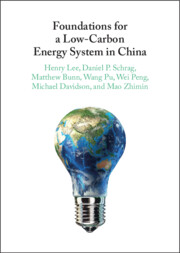Book contents
- Foundations for a Low-Carbon Energy System in China
- Foundations for a Low-Carbon Energy System in China
- Copyright page
- Contents
- Acknowledgments
- 1 Introduction
- 2 Reforming China’s Electricity Market to Facilitate Low-Carbon Transition
- 3 Promoting Large-Scale Deployment and Integration of Renewable Electricity
- 4 Enabling a Significant Nuclear Role in China’s Decarbonization
- 5 Transitioning to Electric Vehicles
- 6 From Barrier to Bridge
- 7 Coordinating Strategies to Reduce Air Pollution and Carbon Emissions in China
- 8 Conclusion
- Index
- References
2 - Reforming China’s Electricity Market to Facilitate Low-Carbon Transition
Published online by Cambridge University Press: 02 December 2021
- Foundations for a Low-Carbon Energy System in China
- Foundations for a Low-Carbon Energy System in China
- Copyright page
- Contents
- Acknowledgments
- 1 Introduction
- 2 Reforming China’s Electricity Market to Facilitate Low-Carbon Transition
- 3 Promoting Large-Scale Deployment and Integration of Renewable Electricity
- 4 Enabling a Significant Nuclear Role in China’s Decarbonization
- 5 Transitioning to Electric Vehicles
- 6 From Barrier to Bridge
- 7 Coordinating Strategies to Reduce Air Pollution and Carbon Emissions in China
- 8 Conclusion
- Index
- References
Summary
In the era of climate change and sustainable development, the main task of China’s power sector is not to expand production, but to promote the transition to a low-carbon energy system. On the generation side, the power sector needs to reduce the share of thermal power, especially coal power, and increase that of nonfossil energy sources; on the demand side, the power sector needs to support electrification of residential and transportation sectors to achieve deep decarbonization and air quality goals. This will significantly increase the uncertainties on both the generation and consumption ends, since nonfossil energy sources, such as photovoltaics and wind power, are highly unpredictable, and large-scale electrification of heating and transportation can increase the volatility of power demand. Therefore, the future power system requires a high degree of technological and operational flexibility to cope with uncertain supply and demand. Our analysis suggests that market-oriented reforms in electricity dispatch and pricing are critical to provide the right incentives to electricity generators and consumers, as well as to promote the adoption of new technologies to facilitate China’s transition to low-carbon energy.
Keywords
- Type
- Chapter
- Information
- Foundations for a Low-Carbon Energy System in China , pp. 15 - 38Publisher: Cambridge University PressPrint publication year: 2021



